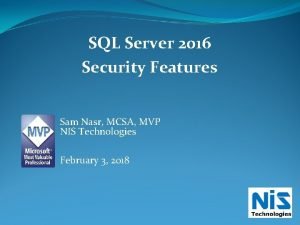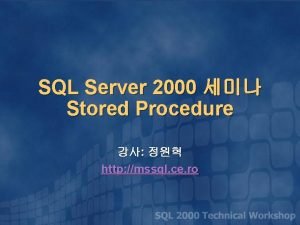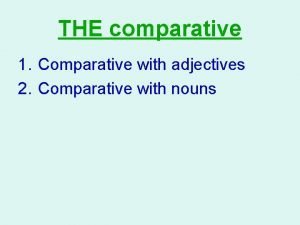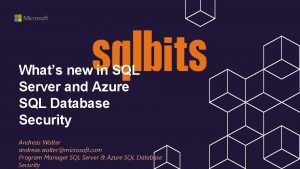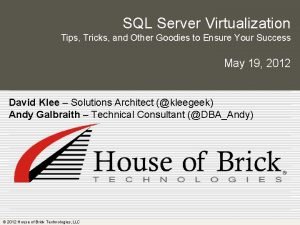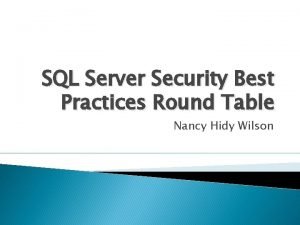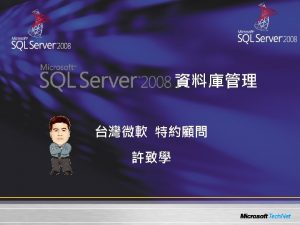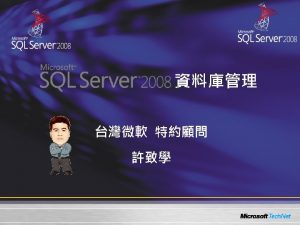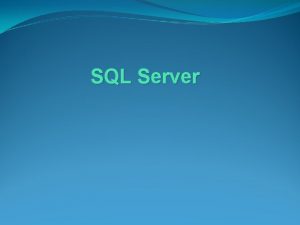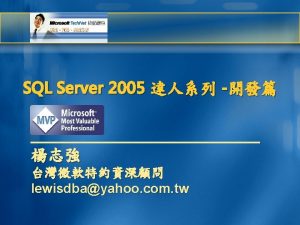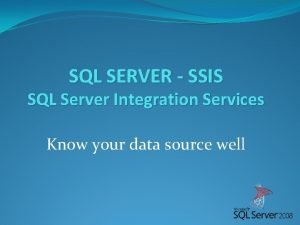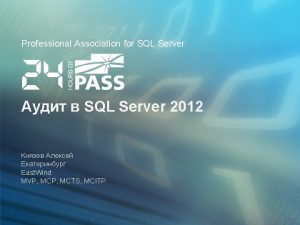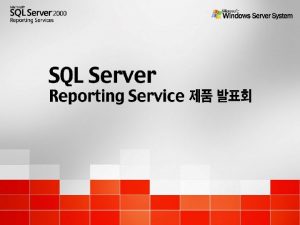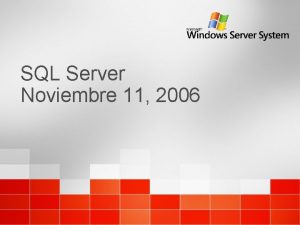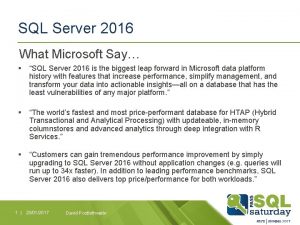Seven Awesome SQL Server Features That You Can







































- Slides: 39

Seven Awesome SQL Server Features That You Can Use for Free Allison Benneth @SQLTran www. sqltran. org

SQL Server Editions SQL 2005 SQL 2008 R 2 SQL 2014 SQL 2016 Enterprise Developer * Datacenter Business Intelligence Standard Workgroup Web Express with Advanced Services Express Local. DB * Free starting with SQL Server 2016

2016 Was a Game-Changer! A lot changed in 2016 March 7 – Microsoft announces SQL Server will be available on Linux in mid-2017 June 1 – SQL Server 2016 is released November 16 – Service Pack 1 is released Many formerly Enterprise Edition features are moved into lower SKUs Including Express Edition and Local. DB! Differentiation by scale, not by feature

New Features in Express Edition (2016) SQL 2016 RTM SQL 2016 Service Pack 1 Stretch DB Query Store In-Memory Tables JSON support Columnstore Temporal tables Snapshots T-SQL additions Partitioning Data compression TIME ZONE Row-level security SESSION_CONTEXT Always Encrypted STRING_SPLIT Dynamic data masking DROP AT IF EXISTS Auditing Polybase (compute node) Additional FILESTREAM support DBCC CLONEDATABASE Management Studio – now a separate install … and free to use All of these features, of course, are in more advanced editions as your application grows!

Limitations on Express Edition Performance One CPU / four cores – per instance 1. 4 GB RAM (buffer pool) – per instance 350 MB for in-memory tables – per instance, not counted toward buffer pool limit – single-threaded only 350 MB for columnstore data – per database, not counted toward buffer pool limit – single-threaded only Functionality 10 GB per database No SQL Agent (service installed, but cannot be started) Schedule backups and other jobs via another SQL Agent or OS scheduler (sqlcmd or Power. Shell)

Limitations on Express Edition Overcomeable No Limitations TCP/IP by default; be sure to enable it Feature Limitations Availability Groups Mirroring Polybase No (head node) SSIS, SSAS, R Server, etc. SSRS with “Express with Advanced Services” Beware! Mandatory telemetry

Cumulative Updates Bug fixes specific to a SQL Server version and service pack Typically Are issued by Microsoft about every two months “cumulative, ” so only need the most recent update Since SP 1 contained new functionality, particularly import to apply Recent CUs go through more rigorous testing; MS recommends applying them by default Current 2017) CU for SQL Server 2016 SP 1 is CU 2 (March 22,

SQL Server 2017 Until April 19, simply referred to as v. Next Current (SQL on CTP 2. 0 (6 th preview version) Server 2016 had 10 preview versions) No release date announced as of yet No edition announcements as of yet New features: availability on Linux, Python integration, adaptive query plans, graph databases

SQL Server Features (Speed Dating) Security Row-Level Always Security Encrypted Utility Snapshots Temporal Tables Performance Columnstore Indexes Partitioning In-Memory OLTP (Hekaton)

Row-Level Security Powerful and flexible way to control who can view or modify data at the row-level grain Access is controlled by a user-defined function that is applied to the table’s security Non-qualifying Select Block rows are silently blocked predicate – controls read access to the row predicate – controls modification to the row (either before or after the modification)

Row-Level Security DEMO

SQL Server Features (Speed Dating) Security Row-Level Always Security Encrypted Utility Snapshots Temporal Tables Performance Columnstore Indexes Partitioning In-Memory OLTP (Hekaton)

Always Encrypted Applies at the column level SQL Server box never sees data in unencrypted form (both at-rest and in-transit) Encrypted columns are stored (and transmitted) as varbinary behind the scenes Certificate is generated on client machine and shared with other clients

Always Encrypted Encryption can be random or deterministic (required if column is indexed or used in a join) Requires a change to the connection string in the application Column Queries Encryption Setting=enabled must be parameterized

Always Encrypted in Action

Always Encrypted - Cons Data size bloat, especially for smaller data types Adds considerable difficulty troubleshooting in tools like SSMS String columns must have a BIN collation – they won’t sort by traditional SQL rules Extra round trips to determine metadata, retrieve keys

SQL Server Features (Speed Dating) Security Row-Level Always Security Encrypted Utility Snapshots Temporal Tables Performance Columnstore Indexes Partitioning In-Memory OLTP (Hekaton)

Snapshots Provides a transactionally consistent, read-only point-in-time view of a database Can take multiple snapshots at different points on the same database Useful for stable reporting against a transactional system Can be used to revert to a previous database state Failed upgrade / administrative tasks QA cycles Resources required dependent mostly on how much underlying database is changed Absolutely, positively not a substitute for proper backups!

Snapshots DEMO

SQL Server Features (Speed Dating) Security Row-Level Always Security Encrypted Utility Snapshots Temporal Tables Performance Columnstore Indexes Partitioning In-Memory OLTP (Hekaton)

Temporal Tables Most applications / databases inherently contain a temporal element If temporal components are tracked, traditionally done with triggers or change detection Temporal Allows tables handle tracking automatically greatly simplified point-in-time querying Requires additional columns on source table and requires history table Schema changes in source table are reflected in the history table

Temporal Tables DEMO

Temporal Tables Temporal querying: FROM Table. Name FOR SYSTEM_TIME _____ Point in time AS OF '2017 -02 -06 11: 30: 00' Full history ALL Between (‘start’ < End. Time AND ‘end’ BETWEEN '2017 -01 -11 18: 55: 04' AND '2017 -05 -06 11: 30: 00' >= Start. Time) From (‘start’ < End. Time AND ‘end’ > Start. Time) FROM '2017 -01 -11 18: 55: 04' TO '2017 -05 -06 11: 30: 00' Contained in (‘start’ <= End. Time AND ‘end’ >= Start. Time) CONTAINED IN ('2017 -01 -11 18: 55: 04', '2017 -05 -06 11: 30: 00')

Temporal Tables Performance Insert operations – no difference than non-temporal tables Update operations – overhead due to writes to both source and history tables Read operations – Default clustered index on history table usually not helpful – consider changing it

Temporal Tables Beware of v 1 limitations! Dropping a column in the source table will drop the column in the history table – all history is lost! Cannot add a non-nullable column to the source table Pruning history is an offline operation

SQL Server Features (Speed Dating) Security Row-Level Always Security Encrypted Utility Snapshots Temporal Tables Performance Columnstore Indexes Partitioning In-Memory OLTP (Hekaton)

Columnstore Indexes Traditional indexes are row-based copies of selected columns in table Columnstore turns this around and orders the index by column Can be the entire table (clustered index) or a subset of columns (nonclustered index) Can be combined with row-based indexes

Columnstore Indexes Previous versions of SQL Server imposed limitations, but SQL Server 2016 removes many of these limits Particularly However Much useful for warehouse / analytic queries performance usually degrades for OLTP workloads of performance benefit derives from high compression of columnstore (typically 20 x or more)

Columnstore Indexes DEMO

SQL Server Features (Speed Dating) Security Row-Level Always Security Encrypted Utility Snapshots Temporal Tables Performance Columnstore Indexes Partitioning In-Memory OLTP (Hekaton)

Partitioning Spread For table data across multiple B-trees example, place older data on slower, cheaper storage Usually for very large data sets, but has other purposes Separation defined by a “partitioning function” and a “partitioning scheme” Range LEFT (think of as >=) Range RIGHT (think of as <) Another use: combine with temporal tables to enable quick archival capability

Traditional SQL Server Index

Partitioned SQL Server Index

Partitioning DEMO

SQL Server Features (Speed Dating) Security Row-Level Always Security Encrypted Utility Snapshots Temporal Tables Performance Columnstore Indexes Partitioning In-Memory OLTP (Hekaton)

In-Memory OLTP First introduced in SQL Server 2014 Stores data in memory Lock-free structures Multi-version Fully ACID compliant (durability optional) Designed Can concurrency control (optimistic) for OLTP workloads yield 10 -20 x performance boost Native compilation of stored procedures

In-Memory OLTP DEMO

In-Memory OLTP Need to give a table hint such as with (snapshot) when used inside an explicit transaction Or, set database option memory_optimized_elevate_to_snapshot Error handling considerations Entire transaction will roll back if validation phase fails (optimistic concurrency assumptions failure)

Resources SQL Server 2016 Express Edition download www. microsoft. com/en-us/sql-server-editions-express Companion blog page to this session www. sqltran. org/7 features Allison Benneth @SQLTran www. sqltran. org
 Awesome sql
Awesome sql Sql server 2016 security features
Sql server 2016 security features If you think you can you can poem
If you think you can you can poem Sql server 2000 stored procedures can:
Sql server 2000 stored procedures can: Phân độ lown ngoại tâm thu
Phân độ lown ngoại tâm thu Block xoang nhĩ độ 2 type 1
Block xoang nhĩ độ 2 type 1 Thể thơ truyền thống
Thể thơ truyền thống Thơ thất ngôn tứ tuyệt đường luật
Thơ thất ngôn tứ tuyệt đường luật Chiến lược kinh doanh quốc tế của walmart
Chiến lược kinh doanh quốc tế của walmart Tìm vết của mặt phẳng
Tìm vết của mặt phẳng Con hãy đưa tay khi thấy người vấp ngã
Con hãy đưa tay khi thấy người vấp ngã Tôn thất thuyết là ai
Tôn thất thuyết là ai Gây tê cơ vuông thắt lưng
Gây tê cơ vuông thắt lưng Sau thất bại ở hồ điển triệt
Sau thất bại ở hồ điển triệt If you can imagine it you can achieve it
If you can imagine it you can achieve it You are what you measure quote
You are what you measure quote If you cant measure it you can't manage it
If you cant measure it you can't manage it If you don't measure it you can't manage it
If you don't measure it you can't manage it Vermögensstruktur kennzahl
Vermögensstruktur kennzahl Awesome mongodb
Awesome mongodb Comparative with and
Comparative with and Proclaim your awesome power
Proclaim your awesome power Our god is an awesome god vine
Our god is an awesome god vine Syntactically awesome stylesheets
Syntactically awesome stylesheets Our god is an awesome god he reigns
Our god is an awesome god he reigns Our god is an awesome god medley
Our god is an awesome god medley We will celebrate our god
We will celebrate our god Awesome adverbs
Awesome adverbs Awesome chinese song
Awesome chinese song Culture shock germany
Culture shock germany God is awesome quotes
God is awesome quotes Awesome power of prayer
Awesome power of prayer Kahootmake
Kahootmake The seven deadly sins
The seven deadly sins Sql and plsql difference
Sql and plsql difference Pl sql unit testing
Pl sql unit testing Sql server roadmap
Sql server roadmap Iometer vmware
Iometer vmware Microsoft sql server security best practices
Microsoft sql server security best practices Sql server security basics
Sql server security basics

